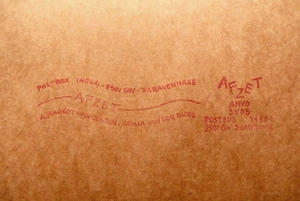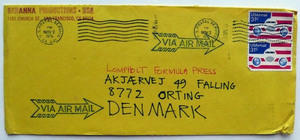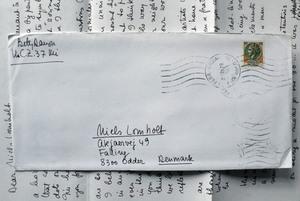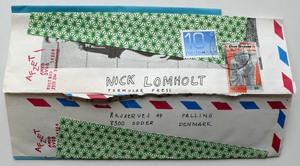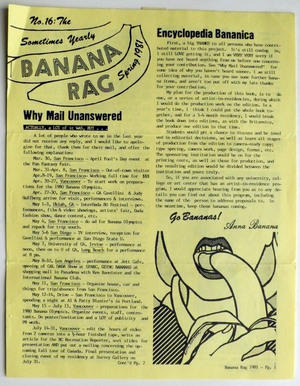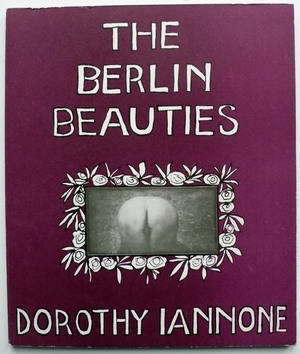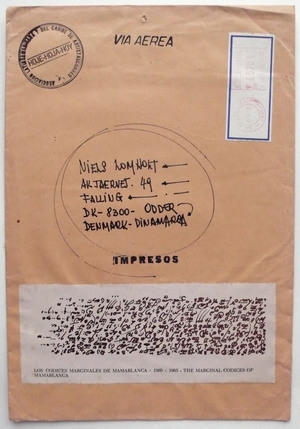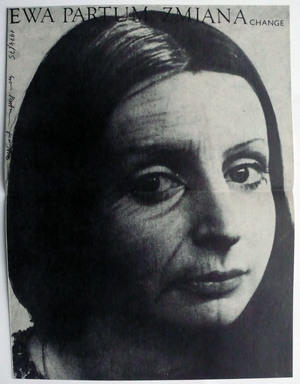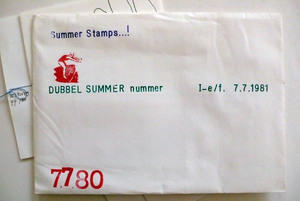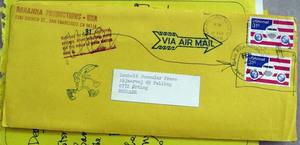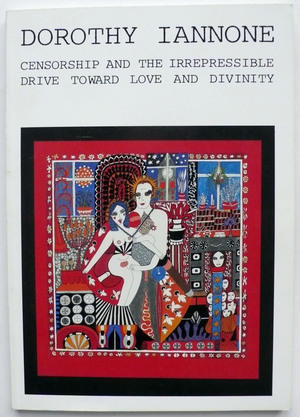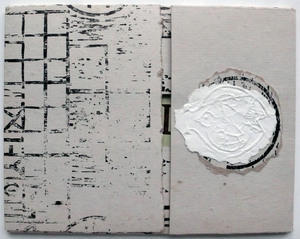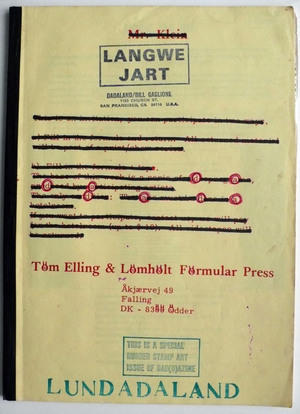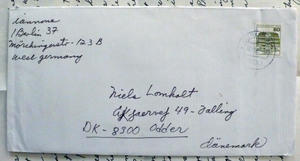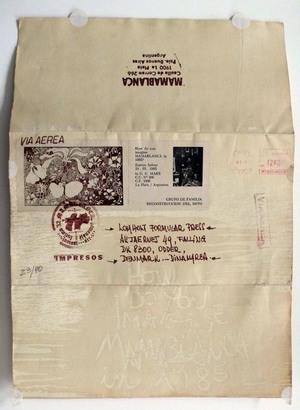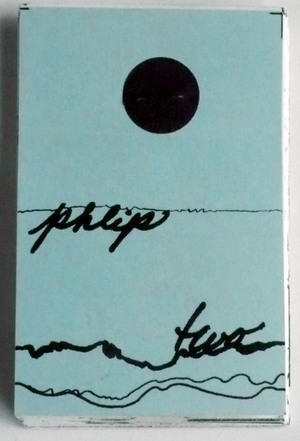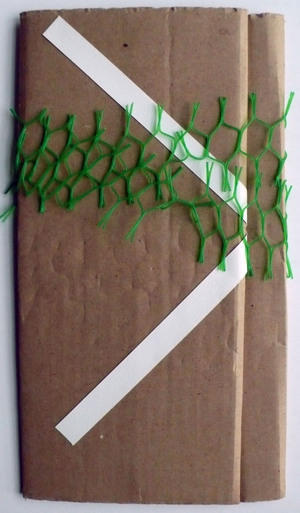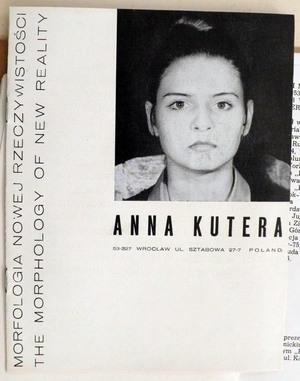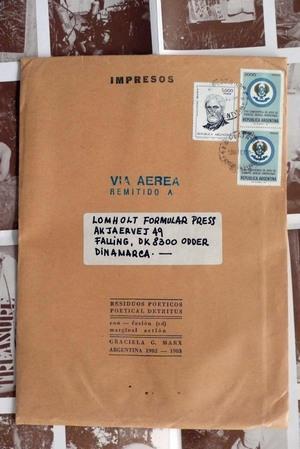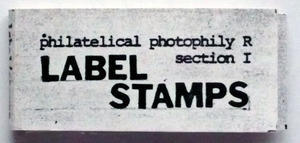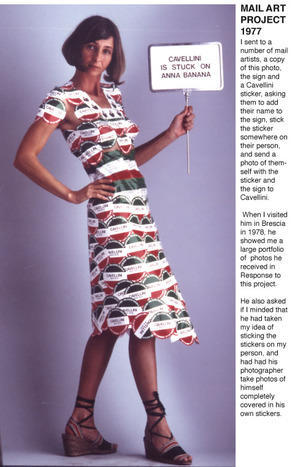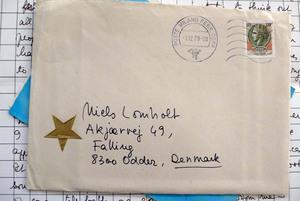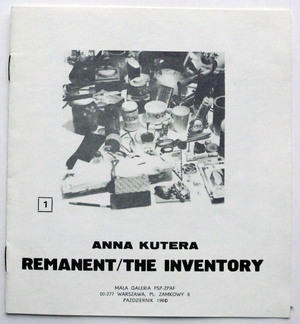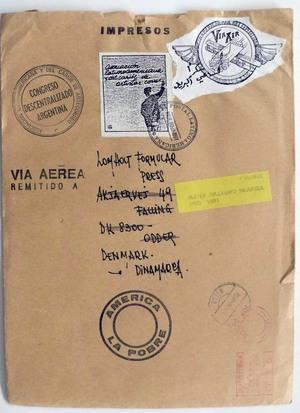FOCUS III | feMail Art
Introduction by Lene Aagaard Denhart
Looking at the Mail Art activities during the period of 1970-1985, a majority male artists presents themselves, however, a large number of female artists had a marked influence also and contributed extensively to the Network. Common to many female artists (as to many male artists) is that they often combine Mail Art networking with other practices, such as the production and editing of publications, performance and/or video, the latter often as a documentary tool. Mail Art is thus build into their practices, as a means of distributing works, information, ideas, artistic and/or political statements, and one-to-one exchanges of work, being fairly simple hands-on strategies.
There were different types of practices:
- Distribution of solo projects, publications or postcard productions, information on exhibitions and events in the network, locally and internationally.
- Invitations (calls for participation) to a Mail Art exhibition with a theme, a common statement of “No return, No jury, all Shown”, mainly shows that usually were followed by a catalogue.
- Dialogue works, being works executed in response to a received piece of work.
Approaching the Network, specific names, dates, and places are important to get an understanding of the variety and frequency of exchanges, and how different nets of relations were formed. Yet, of great significance also, is to understand the function of the distributions in a larger perspective. One of the main ideas of Mail Art was to downplay the importance of individuals and also the common fascination with Art as a commodity. As such, the narrative of Mail Art generally aimed to be the narrative of a social or political situation rather, transgressing more individual concerns. Thus exposing the individual, the play with identity, or identities, was very often executed while contemplating larger agendas. It could be a question of making very personal statements, at the same time giving in your personal name, making af play of shifting identities, or taking on a shared identity. Basically, for the majority of networkers, once you entered the network, the personal activity merged into a common flow and various influences of other posts, works, images and texts, all becoming part of a larger narrative.
This third thematic entry will, under the heading feMail Art, introduce eight of the female artists, including one artist team, who were active in the Mail Art Network between 1970-1985, and represented in Lomholt Mail Art Archive: Afzet (Holland), Anna Banana (Canada), Betty Danon (Italy), Dorothy Iannone (West Germany), Anna Kutera (Poland), Graciela Gutierrez Marx (Argentina), Ewa Partum (Poland), and Marilyn R. Rosenberg (USA). Many other significant female artists could be included, yet beyond the scope of this introduction.
As such, the archive does not exhibit a shared feMail manifesto by the women artists selected, neither a more introductory survey of women involved in Mail Art, as could be seen in the Summer 1978 issue of VILE magazine vol. 6, no. 3. Here, the Mail artist and VILE publisher Anna Banana had gathered a selection of well-established female artists and other Mail artists ”gleaned from the bulging files of the P.A.M. (Postal Art Museum) and the Banana Archives.” (Banana, opening statement).
Reference to the term ”femail art” is first seen in the artist and Mail Art networker Pat Larter’s work, as a rubber stamp on postcards and mailings, an attribution highlighted by Anna Banana in the title concept of VILE magazine vol. 6, no 3. In this issue, all material related to the theme of women involved in Mail Art, and was intended as an ”authentic dossier of documentation of an on-going process”. (Banana, opening statement).
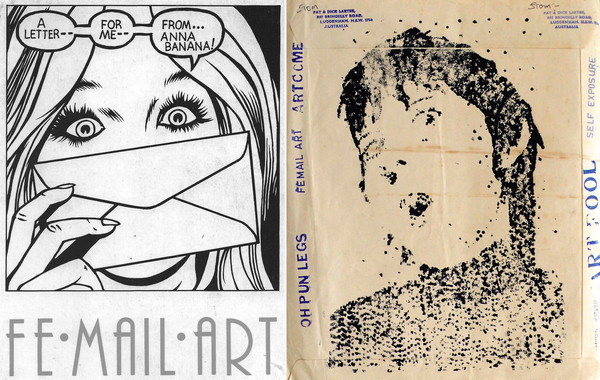
Browsing through the Lomholt Mail Art Archive, it is obvious also that a major part of the works presented are sketches, and materials that relate to everyday concerns, and closely connected also to activities related to specific fractions or nets, within the larger Mail Art Network. In this sense, it is very coincidental what is represented in the archive, which take on the quality of an idea bank, as materials setting of new trajectories. One could add also, that it is the conditions for this type of archive, being of a documentary kind as a gathering of information on activities and Mail Art distributed within the network, rather than being a collection in a traditional sense.
What seem to be shared factor, is the response and interaction which the Mail Art network provided. The selected female artists all vary in approach, yet all seem, in distinct ways and with different means, to unfold, comment, and/or mock established forms – whether directed towards more formal questions, and/or with various degrees of feminist and social agendas. Yet, only rarely seem a message to be stated in a clear or obvious way. Commonly speaking, the artists employ a variety of methods – from speaking in an intimate language, taking the public or groups of people as their subjects, and/or investigate social and relational concerns. Some create work that conceptually speaks to communal identity, and others again are engaged in a practice defined by a performative, process-based, or site-specific approach. While the approach and level of finish or output varies between artists, all artists or networkers share a concern with the everyday experience and the idea of Mail Art as exchange, as creating nets of relations.
The selected practices demonstrate the diversity of Mail Art, and the determination seen in many women artists represented, of spreading the word of their local activities to a broader audience. Their practices mediate social interstices and attempts to redefine community, that revolve around the complex forms of identification which exist between individuals and larger collective entities, identities that engage in constant (re)negotiations through encounters with others.
Afzet (Holland)
The artist group named AFZET aka Sonja van der Burg and Margot van Oosten worked in The Hague, Holland. From 1981 until 1985 they co-edited the international Mail Art magazine called AFZET, published from four to six times a year. Each volume had a special item and artists all over the world were invited to send in material for each volume. All those who had send material received a free issue which were all handmade. The editions compriced ultimately 100 copies of each volume. Like many other Mail Art periodicals, AFZET, challenged the traditional formats and concepts of a publication. There were no set limits for contributions, as to questions of size, format, length, texture, or content, literally nor figuratively. The only set frame was that it needed to be compiled in an envelope.
After a final celebration of AFZET in The Schottenburgh Gallery in Amsterdam, where twelve international artists made installations, and the remaining artists were presented through their mail, performance or video work during the exhibition period, AFZET came to an end – and was the starting point also of the Nouveau Nihilisten and the So-called Window-Gallery.
Posts, Afzet
Afzet's Palmbank 1983-00-00
Letter from Afzet 1984-07-10
Afzet Book Objects 1981-07-07
Afzet's Palmbank 1983-08-29
Paper Object by Afzet 1984-00-00
Anna Banana (Canada)
Anna Banana (b. 1940) is a Canadian Mail artist, performer, writer, publisher and artistamp artist. She lives in British Columbia and has been one of the major contributors to the Mail Art phenomenon and has been circulating her publications and engaging with the public since 1971. She took her nick name at the age of 30, when a man made her fall backwards into a box of bananas. Around 1984 she changed her name from Anne Lee Long and took Anna Banana as her official name. Hereafter, a lot of Banana’s activities, from postcards, collages, and events like the Banana Olympics, the first of which was held in 1975, were based on the connotations of her assumed name. Anna Banana was one of a number of artists who pioneered an important branch of Mail Art, when she created and distributed editions of original postage size artworks called artistamps. She has also produced vast quantities of printed matter, varying from the ephemeral Banana Rag (1971-1991) to the more substantial VILE, one of the Network's better known magazines. VILE, Banana started in 1974 in collaboration with Bill Gaglione, turned out to be an important instrument in the expansion of the Mail Art Network in the seventies. The ephemeral Banana Rag she converted to Artistamp News in 1991 and then passed it on to another Mail artist, Ed Varney (Canada) in 1996.
Generally, certificates were produced in great number within the Mail Art Network, and a typical representative of these is Anna Banana's ”Master Of Bananology” award, which typifies the humorous side of the Mail Art Network.
At the beginning of the new century Banana's Mail Art activities were greatly reduced as she began to move in other directions. She became involved in the making and trading of Artist Trading Cards (ATC's). Trading both by mail and with various artists, in her hometown Roberts Creek where she introduced the activity.
In later years, Banana's performance work has taken on a more serious tone, primarily concerned with the global ecology crisis.
Posts, Anna Banana
Cavellini-stuck-on 1976-00-00
Sometimes Yearly 1976-11-01
Banana Rag - Spring 1981 1981-04-00
Letter from Anna Banana 1976-02-17
The Yellow Book 1978-00-00
Betty Danon (Italy)
Betty Danon (1920 - 2002 April 23, in Milan) was born in Istanbul, and moved out to Milan in 1956, where she exhibited in solo as well as in group shows in many European and overseas countries and participated also in two special exhibitions at the Venice Biennale, in 1978 and 1980.
Danon’s success, in the first twelve years of her practice, was instant and unusual, however, as she was intolerant of any of the rules imposed on artists by art galleries, she turned to cultural circles free from speculations, and increased her relations with international sets, keeping in touch with American and Australian Mail artists and visual poets, with whom she would exchange with until the end of her life. Rather than something to be exhibited, to Danon art became more of an activity and something to communicate, impregnating daily life and leading people to discover and use the wide margin of freedom and creativity that life allows them to experience. At the core of her activity, Danon’s mail-box became a central spot for her to collect mails from artists and networkers from the international network. Danon’s visual poetry exhibits complex, banal, unpredictable, twisted, whimsical, and sometimes thoroughly incomprehensible, plays with words.
Posts, Betty Danon
Letter from Danon 1979-10-15
Letter from Danon 1979-12-03
Letter from Danon 1979-10-22
Dorothy Iannone (West Germany)
The American artist Dorothy Iannone, born in West Germany, presents a unique artistic opus focusing on women's sexual and intellectual emancipation, often presented with a twist of humour and the erotic. Iannone’s oeuvre, which now spans more than fifty years, includes painting and visual narrative, autobiographical texts and films, and has, since the 1960s done pioneering work against censorship. Iannone’s central theme is ecstatic love. The paintings, visual narratives, texts and books draw especially on her own life. Her depictions of the sexual union between man and woman often have an unmistakably mystical dimension rooted in the spiritual and physical union of opposites. This anchors her visual universe within cultural history and lends a modern, personal interpretation to Eastern religions, including Tibetan Buddhism, Indian Tantrism and Christian ecstatic traditions like those of the seventeenth-century Baroque.
Iannone, as her wide body of work suggests, performs as a sort of sex goddess, or matriarch. Since the sixties, she has painted herself having intercourse, incorporating decorative and cultural elements which she absorbed traveling through Europe and the Middle East. The paintings often exhibit a range of barely covered sex organs and myriad climactic gestures, no longer censored.
Posts, Dorothy Iannone
The Berlin Beauties 1977-08-09
Censorship and the irrepressible drive towards love and divinity 1982-00-00
Letter from Iannone 1982-10-12
Anna Kutera (Poland)
Anna Kutera was a member of the Polish group of Contextual Artists who participated in the exhibition “Contextual Art” in 1976 in Lund, Sweden, together with Jan Świdziński, and she represented also the Polish Contextual movement in Toronto at the Center of Experimental Art and Communication, during the meeting and discussion with the American conceptual artist Joseph Kosuth in 1976.
Anna Kutera was closely linked with the artistic community of Wrocław, where she co-created The Recent Art Gallery with the Polish artists Romuald Kutera and Lech Mrożek. In the mid-seventies these artists were spreading the ideas and contextual art theses of Jan Świdziński, which held that the dominant conceptual art model should be replaced by a more pragmatic one, focusing on the concrete context in which art operates, being the social, political, and economic environments.
Kutera’s video performances offers a number of slightly contextual interventions, almost completely integrated in sphere of social interactions and activities. Often through the simplest gestures and the element of chance, and mute encounters, the artist asks questions about the role of the artist in society, with an emphasis on social interactions rather than the artwork itself.
Posts, Anna Kutera
The Morphology of New Reality 1975-08-00
Remanent - The Inventory 1980-00-00
It is me who decides on my head-dress and not some fashion dictators 1981-10-29
Graciela Gutierrez Marx (Argentina)
Graciela Gutiérrez Marx (born in La Plata) is one of the pioneers of experimental art in Latin America. In 1969 she learned about Mail Art and new forms of concrete and visual poetry through Edgardo Antonio Vigo, and she became active in the Mail Art Network in 1975. Her life in Mail Art was shared with Vigo during the black years of dictatorship in Latin America and particularly in Argentina between 1977 and 1983. Together, they worked as G. E. Marx-Vigo.
From the very beginning of the democracy movement she worked with the participants of her Companía de la Tierra Malamada in collective actions, installations and performances, and during the years 1979-1987, she shared drawings and prints extensively with her close mail-friend Michael Scott from England. Nowadays she is in frequent contact with Vittore Baroni, Italy, John Held Jr. and Harley Francis, USA, Araceli Zúñiga and César Espinosa Vera, Mexico, Roberto Farona, España, and György Galántai and Julia Klaniczay from ArtPool, Hungary.
In her own work, Graciela Gutierrez Marx devoted her attention to collaborative projects and the poetics of everyday living as an artistic approach to eliminating the distance between artists, and between the artist and his/her community. As such, for Graciela Gutierrez Marx, true art infuses life and improves the human condition, being the joint political activism together with Vigo, or the more intimate surroundings of her life and family. To Gutierrez Marx ”poetry is to be lived all day long” which is perhaps best expressed through her collaboration with her own family, as is shown in the project Mamablanca, dedicated to her mother, who worked as a primary school teacher throughout her life. The project included contributions from Mail artists throughout the world, of which the project The First Codicies of Mamablanca can be mentioned, compricing a box filled with greetings for her mother’s seventy-fifth birthday. An act of inclusion that elevated Mamablanca from anonymity to become a participant in Mail Art, an activity she continued until her death in 1991. Also her son Martín Raúl Eckmeyer participated in Mail Art from 1978 to 1988 through a series of collaborative drawings they made together. These projects display Guttierrez Marx’s deep-rooted conviction to share her enthusiasm for art with her family, legitimizing it as a worthy activity.
Posts, Graciela Gutierrez Marx
Mail Art Work by Marx 1985-08-16
MaMaBLAnCa 1980-03-00
Mail Art Work by Marx 1985-02-08
Mamablancas treasure 1982-08-10
Letter from Marx 1988-03-21
Ewa Partum (Poland)
Ewa Partum (born in 1945 in Grodzisk Mazowiecki near Warsaw) is a concrete poet, performance and conceptual artist, filmmaker, Mail artist, and feminist engaged since 1969 in linguistic activities, in an attempt to discover a new artistic language. As such, she belongs to the first generation of the conceptual avant-garde in Poland in the 1960s and 1970s and is considered to be a pioneer of feminist art. Her work carries a strong feminist and a social tone, although this is never stated in a clear or obvious way.
Partum’s work includes actions, objects, photography, films that she herself calls ”tautological cinema”, visual poetry performances, and Mail Art. Ewa Partum defines the essence of her work as: ”the act of thought is an act of art”. The Tautological Cinema: Poem by Ewa (1973), is a film documentation of ephemeral activities centred around visual poetry, as the scattering of single letters of the alphabet, thrown into the wind, or into the sea. This work can be seen as a continuum of pieces like The Area on Poetic Licence (1971) and Active Poetry (1971), which aimed at deconstructing traditional canons and forms of poetic expression, and to replace conventional grammar and linear syntax of language with more open, processual structures. The intention was hereby to incorporate into their becoming the element of chance and the creative activity of the recipient. This gesture of deconstructing syntactical and grammatical structures of language and the creation of anarchist and ephemereal poems may be seen in light of later feminist artistic activities as acts of contesting language and patriarchal values.
Since the late seventies Ewa Partum gradually moved from the issues of autonomous conceptual art and contemplation of purely artistic problems towards an emphasis on feminist issues in her creative work. This transition were marked by the use of the artist's own naked body in her performance art. Partum appears naked to stress a specific ”location” and ”subjectivity” of her creative expression, as the need to stress that she is, first and foremost, a woman who speaks.
Posts, Ewa Partum
Book by Ewa 1975-08-00
Change 1975-08-00
Marilyn R. Rosenberg (USA)
Marilyn R. Rosenberg (born 1934, Philadelphia PA) has published visual poems in artists' books from Redfoxpress, Luna Bisonte Prods, Printed Matter, Otoliths, and many other places, and has continued to produce Mail Art works. Either as long distance interactions through snail mail, but increasingly often through the internet or in a combination of both, which results in collaborations that get published from time to time. Her works are represented in a wide variety of places on the web.
Rosenberg in a sense has exploded the concept of book through the acts of cutting, folding, drawing, the use of collage, color, and paint. The books are transformed into sculptures, or book objects, and similarly the words inside are made into visual poems, so that all aspects of the book are transformed, as objects. The focus on their efficacy to deliver knowledge are displaced and our attention are led to contemplate the subtle beauty of the objects, being the book format itself, or the written word. Aspects of rhythm, balance, dissonance, sequences, and pace becomes important, and makes the process of decoding the work, one of visual and rhythmic contemplation.
Posts, Marilyn R. Rosenberg
One Way 1977-00-00
Photophily Phlip Pack 1980-00-00
Philatelical Photophily 1982-00-00
Postcard from Rosenberg 1983-06-17
Although this FOCUS essay on feMail art has not been intended as a feminist demonstration, obviously the question presents itself as to whether one can distinguish certain characteristics of art created by female artists, whether any particular features and agendas presents themselves. One could perhaps quietly provoke such a discussion again, by engaging further with the selected female artists – and others within and beyond the archive – and ponder if, in their works, there is something you would detect as other imaginations, a certain sensibility, and/or a different approach to the world.
